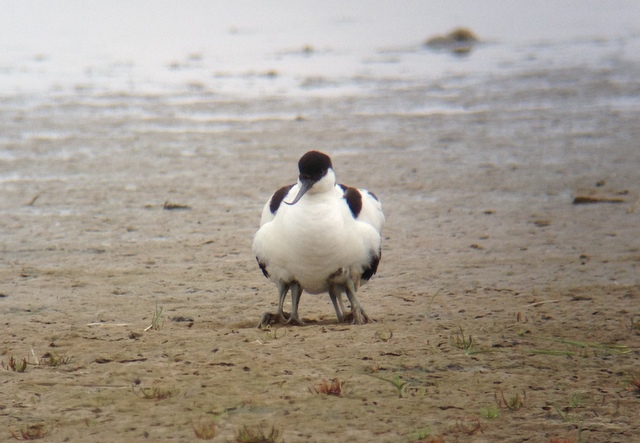A Summer Tour today, it was billed as Spoonbills & Dartford Warblers and that was exactly what we did. And a lot more besides!
The day started cloudy and cool. Rather than head up to the Heath first, as we might normally do, we thought it might be better to have a look around Cley this morning. We were glad we did. As we walked into Teal Hide, we could see a few small waders on the mud on the island in front. A quick look through the scope confirmed that one of them was the White-rumped Sandpiper, a rare visitor from North America which has been around the reserve intermittently for over a week now.
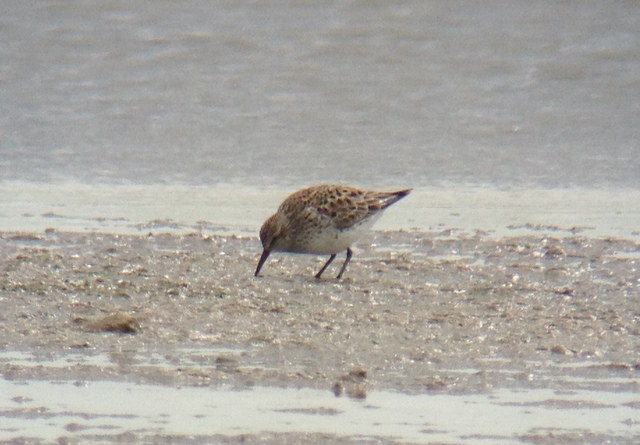 White-rumped Sandpiper – we just got a good look at it before it flew off
White-rumped Sandpiper – we just got a good look at it before it flew off
It was feeding with three Dunlin, their black belly patches immediately distinguishing them, and a single Ringed Plover. We had just had a good look at them when suddenly the little group took off and disappeared away to the north-east, out over to the sea. That was the last time the White-rumped Sandpiper was seen all day.
There were lots of other birds on the scrapes today – it was a real wader-fest. It was a slow spring for waders, so it was great to see so many today. At this time of year, it is hard to tell whether they are late birds heading north or, more likely now, early birds already returning south. First two Greenshank dropped into Pat’s Pool and they were steadily joined by more until we had at least six together. Then a lovely black summer plumage Spotted Redshank flew in. What a stunner! It fed next to a Common Redshank first, before flying over to join the Greenshank, giving us a great opportunity to compare the structure of the three ‘shanks.
Several Little Ringed Plovers were out on the islands – we could see their golden yellow eye-rings through the scope – and a small group of Ringed Plovers (of the tundrae race) were feeding on the mud in front of Dauke’s Hide. Three Knot, one sporting a little bit of orange on its underparts, were in amongst the Black-tailed Godwits. A single Bar-tailed Godwit was sleeping in front of one of the islands on Simmond’s Scrape.
The Avocets put on a good show as usual. There was a little family of four fluffy little juveniles on the island in front of Teal Hide. They seemed to be happy enough feeding out on the mud, but when mum called, they ran over to her, she knelt down and they snuggled in underneath her belly feathers.
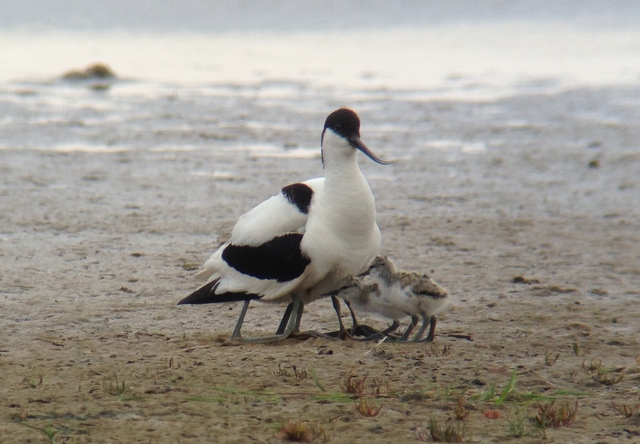 Avocet & chicks – now you see them…
Avocet & chicks – now you see them…
There have been several Little Gulls at Cley for some time now and today was no exception. We counted five, again all 1st summer birds and again all sporting varying amounts of black summer-plumage hood.
 Little Gull – five 1st summers at Cley again today
Little Gull – five 1st summers at Cley again today
Out on Simmond’s Scrape, we could see a long line of white blobs – Spoonbills, twelve of them today. Once again, they were all doing what Spoonbills like to do most, sleeping. They did wake up occasionally, and when they did we could see they were a mixture of adults and juveniles, the latter smaller and with their bills not yet fully grown. The adults also sported a black bill with yellow tip, lacking in the youngsters, and a crest of feathers on the back of the head.
 Spoonbills – twelve on Simmond’s Scrape this morning
Spoonbills – twelve on Simmond’s Scrape this morning
 Spoonbills – four short-billed juveniles
Spoonbills – four short-billed juveniles
Having enjoyed all the excitement on the scrapes, we decided to go for a walk round to the East Bank. It was very windy up on the bank itself, and hard to focus on the birds at times. There were several Lapwing and Redshank on the flooded grazing marshes, as usual, and a few Avocets on the pools. A single Golden Plover out on the grass was a surprise. There were lots of Black-tailed Godwits asleep in the grass. Duck excitement was provided by a little group of Teal – numbers are slowly creeping up again now.
While we were scanning the Serpentine, there was a huge commotion over Arnold’s Marsh, as hundreds of waders and terns took to the air in a cacophony of noise. A quick look soon revealed the culprit – a Marsh Harrier was flying over, pursued by a little posse of Avocets. They chased it right overhead and out onto the reedbed.
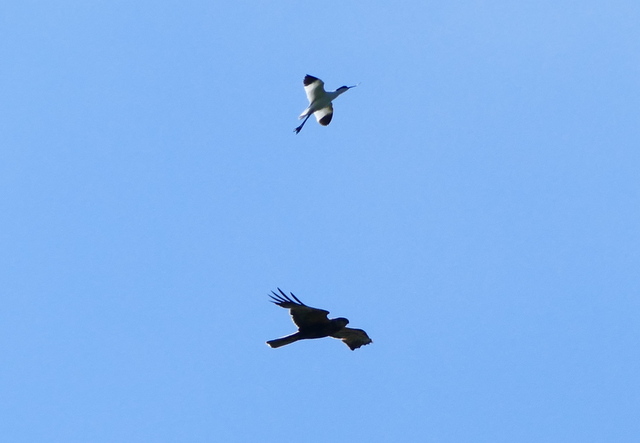 Marsh Harrier – mobbed by Avocet
Marsh Harrier – mobbed by Avocet
As the waders settled back down, lots of them came into land on the grass by the Serpentine. Mostly, they were more Black-tailed Godwits, but looking through the flock we discovered a single male Ruff, still in stunning summer plumage, with exotic looking rufous and white neck feathers. Down on the mud on the bank of the Serpentine, we could see a couple of Ringed Plovers, this time larger, paler birds of the local breeding race hiaticula.
There were lots of Reed Warblers and Sedge Warblers around the reedbed as usual, but they were hard to see in the wind today. The Reed Buntings were a little more obvious. However, we really wanted to see Bearded Tits. We could hear them and we had several frustratingly quick flight views, before we eventually found a smart male which perched up in the tops of the reeds briefly. A pair also then flew past us close and landed in the reeds the other side of the bank.
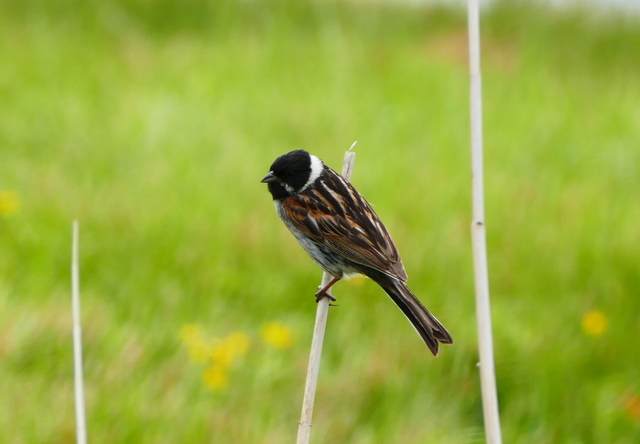 Reed Bunting – more obliging than the warblers at Cley in the wind today
Reed Bunting – more obliging than the warblers at Cley in the wind today
A lot of the birds we had seen circling earlier, as the Marsh Harrier went over, had landed back on Arnold’s Marsh. There was an impressive flock of waders roosting out on the water. Scanning through, we could see that the largest number were Knot, at least 130 today and almost all mostly in grey winter plumage apart from one more orangey one. There were also good numbers of Bar-tailed Godwit as well, numbering at least 60 and again with only one sporting any degree of orange summer plumage. We had seen a little group of around 10 Grey Plover in flight but they were more scattered around the various islands now. However, a couple were still in stunning black-bellied plumage. There were also two large Curlew on the edge of the throng.
As well as all the waders, there was a noisy flock of terns out on Arnold’s. Mostly Sandwich Terns, with shaggy crests and yellow-tipped black bills. Tucked down on one of the shingle islands, we could see three Common Terns as well, smaller, slimmer, with a sleeker black crest and black-tipped orange-red bill.
By this stage, it was already getting on for lunchtime, so we were glad to walk back and get off the East Bank and out of the wind. Still, it wasn’t so bad at ‘ground level’ that we couldn’t sit outside and eat our lunch at the picnic tables. A female Marsh Harrier drifted past close by and a Cetti’s Warbler shouted from the reeds across the road.
After lunch, we headed up to the Heath. A windy day is not the best to explore here, as the birds can often be tucked down, but we did remarkably well today all things considering. A Turtle Dove had been purring from some birch trees, but we couldn’t see it at first. It was only as we were walking away that we spotted it flying between branches. We got the scope on it and could see it amongst the foliage, particularly as the wind periodically parted it.
 Turtle Dove – hiding amongst the leaves of a birch tree
Turtle Dove – hiding amongst the leaves of a birch tree
We could hear a Dartford Warbler singing, but it seemed to be keeping down deep in a large clump of gorse. The next thing we knew it had moved a distance away out of the back, and we just caught a glimpse of it singing from the top of a bush. It flew back towards us, dropping into the gorse and heather a couple of times, before coming right past us. We could see it was carrying nesting material.
We carried on round the heath. There were lots of Linnets and several Yellowhammers singing as usual. We heard another Turtle Dove purring briefly, but couldn’t find it once it went quiet. A Cuckoo was singing and a Hobby flashed over. There was no sign of the other male Dartford Warbler which has been singing this week – it was possibly too windy for it to perform. However, while we were waiting for it, a Woodlark appeared on a dead tree stump, giving us nice scope views. A smart male Stonechat also perched up nicely, as they tend to do.
We walked back the way we had come. The first male Dartford Warbler was still singing, in much the same area as we had heard it earlier. We patiently followed it, singing almost all the time as it moved through the gorse. Eventually it hopped up onto the top, gave a quick burst of song and launched itself into a song flight. It dropped back down into the dense gorse, still singing, before a female Dartford Warbler flew across to join it. Then the two of them disappeared into the undergrowth and went quiet.
On the walk back, we stopped to admire a little group of Silver-studded Blue butterflies fluttering amongst the grass in a clear area. We could see the wider black margins to the blue upperwings and the silvery blue-centred marginal spots on the hindwings.
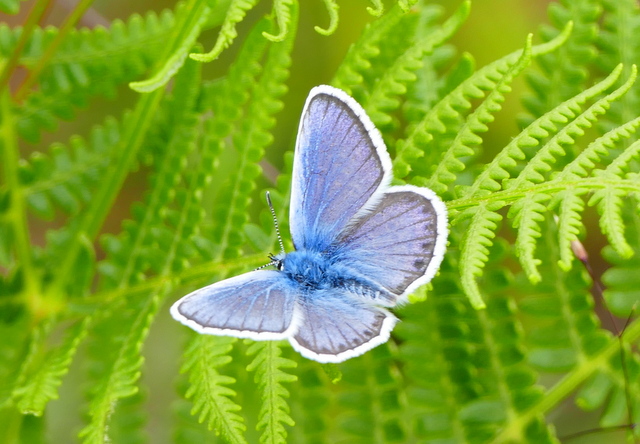 Silver-studded Blue male – the black margins are wider than Common Blue
Silver-studded Blue male – the black margins are wider than Common Blue
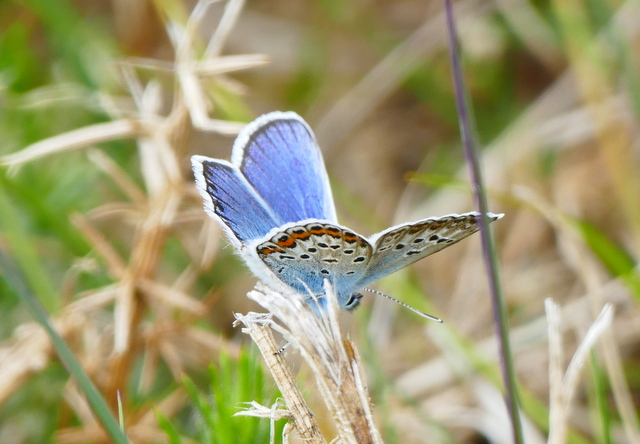 Silver-studded Blue – with silver-centred black spots on the underwing
Silver-studded Blue – with silver-centred black spots on the underwing
We still had time for one last walk, so on our way back we stopped at Salthouse. We could see a single adult Spoonbill feeding out on the pools in front of the pub as we drove past, and another three Spoonbills by the Iron Road. We walked out along the latter and had a good look at them before they flew off – two juveniles and a presumed 1st summer.
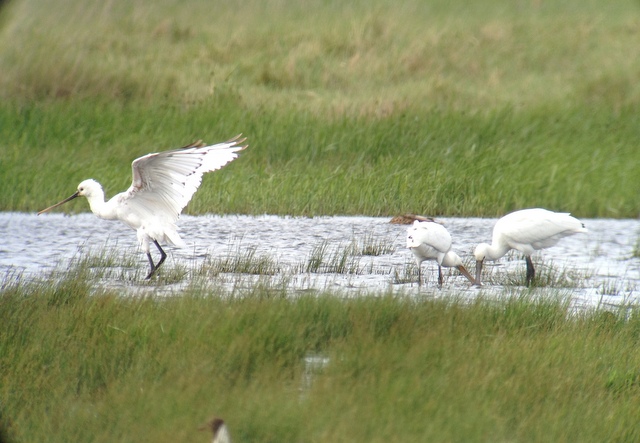
 Spoonbills – another three by the Iron Road this afternoon
Spoonbills – another three by the Iron Road this afternoon
There were also lots of Sand Martins hunting low over the water. A couple of Meadow Pipits were song-flighting, fluttering up before parachuting back down to the ground. A fly-over Pochard was another addition to the day’s list. Then it was time to call it a day and head home.
Spoonbill – check, Dartford Warbler – check, and don’t forget everything else!
